|
|
Post by toad on Dec 5, 2010 16:20:36 GMT -5
Cleaning seeds from eggplant (aubergine) 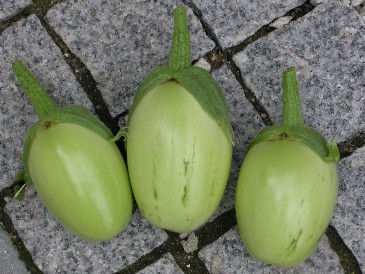 Applegreen is an eggplant breed for northern climates by Professor Meader of New Hampshire and released in 1964 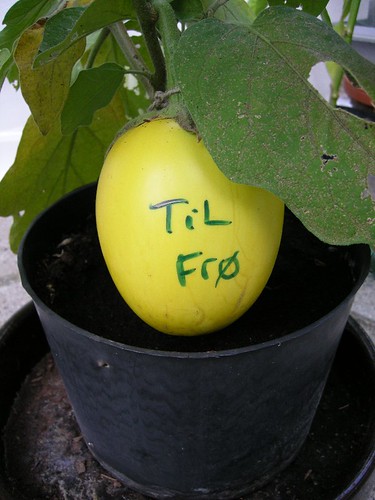 I tried to save seeds from eggplant a few years ago. I even made a succesfull test of germination same autumn. But in spring there were no more germination. Oh-oh-oh - what an embarrasment, I had been sharing my seeds, and emails started to come in. All polite emails, but I myself was very disappointed and angry with myself. Now I find it more easy to forgive others who had accidents with the seeds they send me. 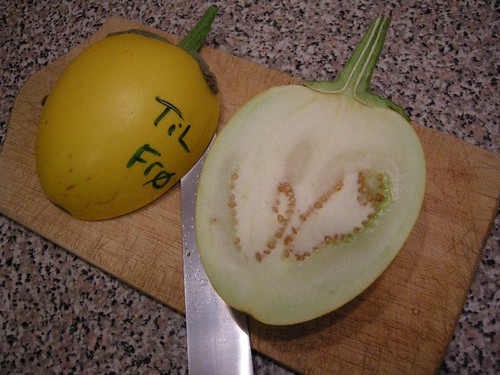 To do it better this time, I reserved the very first fruit for seeds, even wrote on it, to avoid any mistake at suppertime. Now I have been waiting for this fruit since mid july. Today (October) I decided to cut it open, since it has been all yellow for very long time, and stopped shining for some time. ![]() farm3.static.flickr.com/2370/1507648887_51238080fe_m.jpg farm3.static.flickr.com/2370/1507648887_51238080fe_m.jpg [/img] Scooping out the pulp and seeds into a bowl 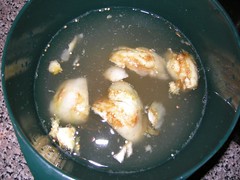 Seperating eggplant seeds from pulp in water, just give them a good kneading. Seeds sinks to the bottom whereas pulp float - a nice piece of low technology. ![]() farm3.static.flickr.com/2197/1508508762_47b807f9bc_m.jpg farm3.static.flickr.com/2197/1508508762_47b807f9bc_m.jpg [/img] Washing eggplant seeds thoroughly prevents seeds sticking together. 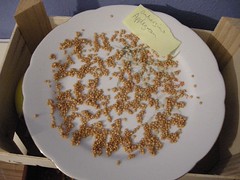 Drying eggplant seeds on a plate. Now I just have to be patient and wait until they are completely dry before storing in an envelope. From my blog toads.wordpress.com/2007/10/07/applegreen-saving-seeds/ |
|
|
|
Post by flowerpower on Dec 6, 2010 6:36:13 GMT -5
Thanks for posting this here, Toad.  It's very informative. |
|
|
|
Post by bluelacedredhead on Dec 6, 2010 8:34:30 GMT -5
Yes, TY.
FP, just imagine, if we ever get eggplant to grow in sufficient quantity to save seed for more than ourselves, we will know how to save the seed, lol
|
|
|
|
Post by ottawagardener on Dec 6, 2010 9:01:44 GMT -5
|
|
|
|
Post by galina on Dec 6, 2010 11:44:12 GMT -5
Thank you for the instruction. I have only ever sliced them and wiggled the seeds out with my hands. I will try your method next time.
|
|
|
|
Post by orflo on Dec 6, 2010 13:16:42 GMT -5
Telsing, be careful here. I once used a mixer to separate the seeds and lots of them ended up broken. I use a wooden mallet nowadays, and hit from all sides on the ripe fruit, I make sure I don't hit too hard, but just enough to turn it into something softer. After that I use the method Toad uses, water them and dry the seeds. |
|
|
|
Post by ottawagardener on Dec 6, 2010 14:22:01 GMT -5
Wacking them sounds more fun than whizzing.
|
|
|
|
Post by toad on Dec 8, 2010 13:10:05 GMT -5
OK folks, I just realise I wasn't clear on one thing.
In the water, I knead the cubes by hand. I very quickly done, but necessary to free the seeds.
I've just modified the tutorial on that.
|
|
|
|
Post by kermyt on Mar 11, 2012 14:14:29 GMT -5
Very good lesson!
A grater is a very good alternative to the blender... Less aggressive but very efficient!
The fruit look young to extract seeds no..? (the flesh is very clear).
I heard it's possible to finish the ripening ,after the fruit is cut, in the house. The seeds are extract during the winter or very early in spring...
|
|